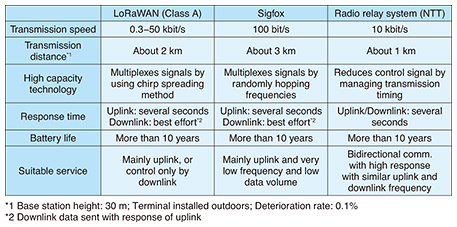 |
|||||||||||||||||||||
|
|
|||||||||||||||||||||
|
Feature Articles: Wireless Access Technology to Meet Diverse Needs from IoT/M2M to Broadband Vol. 15, No. 3, pp. 20–26, Mar. 2017. https://doi.org/10.53829/ntr201703fa4 Development Efforts on Wide Area Wireless Access to Accelerate Its Use for M2MAbstractThe Internet of Things (IoT), in which everything is connected to the Internet, has recently been attracting a lot of attention. NTT has been undertaking various initiatives such as research and development and field trials to realize IoT services. This article describes the requirements of IoT/M2M (machine-to-machine) services and outlines the low power wide area (LPWA) network. It also introduces a field trial utilizing the LPWA network implemented by NTT WEST and a wide-area and high-capacity radio relay system developed by NTT. Keywords: IoT/M2M, LPWA, smart metering 1. IntroductionMachine-to-machine (M2M) communication systems have been attracting a lot of attention recently. The concept of the Internet of Things (IoT) involves connecting everything around us to the Internet [1]. The information that comes from these multiple components will be collected and analyzed in a network. This information will then be utilized as big data and is expected to lead to the creation of new value services. In an IoT/M2M service, the terminals to be connected are dotted everywhere, and it is necessary to accommodate them efficiently. Examples are the smart metering of electric power and gas meters currently being introduced as well as agriculture sensors. Since their terminals will be widely dispersed, a wide-area but high-capacity network is necessary. NTT WEST is working on the creation of IoT usage scenes and the development of new services in conjunction with partners in various fields. A key development is field trials with a low power wireless access (LPWA) network that adopts LoRaWAN*1. NTT Network Innovation Laboratories has developed a wide-area and high-capacity radio relay system for a smart metering service and has concluded tests on a liquefied petroleum (LP) gas centralized monitoring system.
2. Requirements of M2M services and overview of LPWAM2M services clearly create different wireless loads from those of personal communication devices such as cellular phones. Most M2M service terminals cannot move independently and thus remain stationary for long periods. The typical communication environment expected for M2M services is depicted in Fig. 1. We assume the wireless environment has the following three requirements: 1) Wide area: A terminal cannot be moved easily even if its wireless environment is inadequate. For example, the access point and terminal may not have a direct line of sight. Thus, communication must be established even in difficult circumstances. 2) High capacity: It is assumed that each access point may have to support many terminals that are likely to transmit simultaneously after a disaster. Therefore, it is necessary to be able to communicate with many terminals. 3) Long battery life: It is assumed that a terminal may have no AC (alternating current) power supply, or that some terminals will be hosted by the social infrastructure so that their operation will be managed over a decade-long period without replacing the battery. Therefore, a long battery life must be achieved while maintaining low power consumption.
To satisfy these requirements, wireless communication standards have been formulated to suit various usages [2]. For 3GPP (3rd Generation Partnership Project), standardization of Cat. NB1 and Cat. M were completed in 2016 as IoT standards, and development is now underway for their commercialization. LPWA using the sub-gigahertz band, which is the unlicensed band, is beginning to be used mainly in Europe and the United States. Since the sub-gigahertz band is lower than the 2.4-GHz band used in wireless LANs (local area networks), it has less attenuation and offers high diffraction performance, so it can cover a wide area with one base station. It can also achieve low power consumption of terminals and can accommodate many terminals. LoRaWAN [3] and Sigfox [4] are major LPWA networks currently being widely used in Europe. They are used for infrastructure monitoring and other services. In Japan, the Association of Radio Industries and Businesses (ARIB) issued standard STD-T108 [5] for the 920-MHz band as an unlicensed band in 2012. It is used by Wi-SUN (Wireless Smart Utility Network). NTT Network Innovation Laboratories has developed a 920-MHz band radio relay system for a smart metering service. The characteristics of the major LPWA networks are described below and summarized in Table 1.
(1) LoRaWAN LoRaWAN achieves long distance communication of up to 2 km by using a variable transmission rate from 0.3 to 50 kbit/s. In addition, it offers high accommodation performance by multiplexing signals of different transmission rates using chirp spreading. Three protocols, Class A to C, are prescribed, but Class A is the main type being considered. Class A achieves a battery life of more than 10 years by eliminating the periodic reception operation of the terminal and sending downlink data together with the uplink response. Since downlink communication is best effort, it is assumed that it will be applied to services that mainly collect sensor information (such as infrastructure management, logistics, and agriculture) and services that realize control only through downlink communication. (2) Sigfox Sigfox achieves long distance communication of about 3 km by lowering the transmission rate to 100 bit/s. It achieves high accommodation performance by randomly hopping frequencies at the time of transmission and by multiplexing a large number of uplink data flows in the same frequency band. Furthermore, similar to Class A of LoRaWAN, the downlink communication is best effort, thereby realizing low power consumption of terminals. It is assumed that it is applied to services using uplink communication and very low frequency and low data volumes (such as state monitoring). (3) Radio relay system The radio relay system developed by NTT Network Innovation Laboratories is a specification guaranteeing the downlink response time. For this reason, it will be used for bidirectional communication, in which the frequencies of uplink communication and downlink communication are about the same and high response performance is required (services include smart metering, equipment control, etc.). The communication requirements of M2M services are diverse. For example, for infrastructure management and environmental monitoring, the main traffic consists of uplink communication that collects sensor information. Also, in applications where a delay of more than several seconds is allowable, it is possible to perform downlink communication by responding to periodic uplink communication. Meanwhile, for smart metering, high-response bidirectional communication is necessary in order to acquire meter information, determine the state, and control the meter. To satisfy the communication requirements of these diverse M2M services, it is important to select and use the appropriate wireless system for each service from among the wireless systems available. 3. NTT WEST field trialIn these trials, NTT WEST provides an LPWA network that uses LoRaWAN, whose specifications have been formulated and promoted by the LoRa Alliance, with which approximately 400 IoT-related companies are affiliated [6]. A depiction of the trials is shown in Fig. 2. The trial partners prepare devices, sensors, platforms, and other elements on their own and connect them to the LPWA network provided by NTT WEST. The trials are being conducted in order to verify functions and operational requirements for IoT services on LoRaWAN and to create usage scenes of IoT services and verify business possibilities. Semtech Corporation (USA), which is in the process of formulating Japanese standards of LoRaWAN, is providing information on the outline and technical requirements of LoRaWAN.
The first trial was conducted in Yasu City, Shiga Prefecture. The trial implemented agricultural remote control systems such as those for water supply management, water level, and temperature control utilizing multifunctional automatic water faucets. Due to large-scale farming and conversion of single cropping fields (rice paddies etc.) into multiple cropping fields, labor saving in water management and demand-led water use have become necessary. In response to this situation, the feasibility of water management to suit different forms of agricultural management will be investigated. The intent of the communication carrier is to verify radio wave propagation characteristics and power saving compared to existing communication methods such as Wi-Fi*2.
4. Radio relay system suitable for smart meteringSmart metering systems that can automate monthly meter reading and enable visualization of electricity consumption in conjunction with HEMS (home energy management systems) are now being introduced by various electric power companies [7]. A gas smart metering system for the automation of gas meter reading and visualization of gas usage is being actively targeted. The U-Bus Air system has been standardized by the nonprofit organization Japan Utility Telemetering Association in order to achieve a gas smart metering system [8]. In response, we have developed a wide-area and high-capacity IoT/M2M radio relay system that suits the gas smart metering system. The system configuration is shown in Fig. 3. The system uses a multi-layer relay system; the lower layer utilizes the user network to connect directly with the user terminal such as the gas meter, and the relay layer is our developed radio relay system. The system offers a flexible area design in conjunction with the user network. Furthermore, since a large number of user terminals can be aggregated, it is possible to economically connect more user terminals to the server with one public line such as 3G or LTE (Long Term Evolution).
However, the following problems with the relay layer system need to be solved in order to satisfy the communication requirements of IoT/M2M. 1) Compatibility of a broadening area and high capacity accommodation 2) Power savings from the relay terminals In order to broaden the area of the relay layer, it is necessary to lower the transmission speed. The amount of data that can be transmitted decreases due to the lower transmission speed, so the accommodation capacity of the relay layer decreases. Furthermore, transmission and reception times of the relay terminal will increase due to the reduced transmission speed, which will increase the power consumption. For that reason, it is necessary to strike the right balance between a wide area, high capacity, and low power consumption. Intermittent operation is required in order to maximize power savings. The radio relay system that performs intermittent operation normally needs to send and receive control signals in order to maintain synchronization between the relay base station and the relay terminal. However, as the number of relay terminals increases, interference due to control signals from the relay terminal increases. To avoid this interference, it is necessary to reduce the transmission frequency of the control signal from the relay terminal. However, if the transmission frequency of control signals is reduced, the transfer delay will increase and fewer applications will be supported. In order to reduce the transmission frequency of the control signal without degrading the transfer delay, the radio relay system uses a method that enables the relay base station to manage the transmission timing of all subordinate relay terminals. As a result, interference can be reduced, so throughput is improved, as is capacity. Furthermore, since the transmission frequency of the control signal decreases, power saving of the relay terminal becomes possible. Under the assumption that each user terminal generates communication traffic of 1 kbyte per day, each relay base station can support up to 2000 user terminals. Furthermore, each relay terminal can have a battery life of 10 years. As a result, the radio relay system can satisfy the requirements of the LP gas centralized monitoring service (wide area with low user density) and the urban gas smart metering service (with many gas meters). In addition to gas smart metering, it is also being applied to other M2M services that require interactivity such as social infrastructure control. 5. Future overviewNTT WEST is planning to consider the usage scenes of the LPWA network in various IoT services based on the network technology know-how obtained from the field trials. NTT Network Innovation Laboratories will continue its research and development activities to further enhance the wide area, high capacity, and power savings of radio relay systems, in order to enable them to be shared by various M2M services beyond gas smart metering (Fig. 4).
References
|
|||||||||||||||||||||












